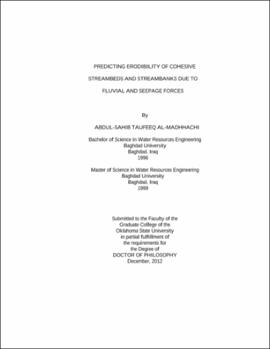| dc.contributor.advisor | Tyagi, Avdhesh K. | |
| dc.contributor.advisor | Fox, Garey A. | |
| dc.contributor.author | Al-Madhhachi, Abdul-Sahib Taufeeq | |
| dc.date.accessioned | 2013-12-10T18:05:30Z | |
| dc.date.available | 2013-12-10T18:05:30Z | |
| dc.date.issued | 2012-12 | |
| dc.identifier.uri | https://hdl.handle.net/11244/7831 | |
| dc.description.abstract | Scientists and engineers need to predict the erosion rate of cohesive soils due to fluvial and seepage forces. However, currently mechanistic approaches are unavailable for incorporating seepage forces into the commonly used excess shear stress model. A more mechanistically based detachment model, the "Wilson Model," is proposed in this research for modeling the erosion rate of soils using the hydraulic analysis of a Jet Erosion Test (JET). Seepage forces were incorporated into a mechanistic fundamental detachment rate model to improve predictions of the erosion rate of cohesive soils. A new miniature version of the JET device ("mini" JET) and flume tests were conducted on two cohesive soils (silty sand and clayey sand) to derive the "Modified Wilson Model" parameters (b0 and b1) in order to investigate the influence of seepage on the soil erodibility. The "mini" JETs were also performed on a horizontal experimental setup to mimic a streambank case. | |
| dc.description.abstract | The "mini" JET established equivalent predictions of the soil erodibility to the larger original laboratory JET for the two cohesive soils. The original and "mini' JETs can provide equivalent results to flume experiments for deriving the "Wilson Model" parameters b0 and b1 as well as to the excess shear stress parameter, kd. Seepage forces had a non-uniform influence on the derived parameters (b0 and b1) as functions of the hydraulic gradient and dry density. The influence of seepage forces can be predicted using JET techniques by incorporating the known seepage gradients into the "Modified Wilson Model" parameters (b0 and b1) from performed JETs without seepage on streambeds and streambanks. The "Wilson Model" and/or "Modified Wilson Model" is advantageous in being a more mechanistic, fundamentally based erosion model as compared to the excess shear stress model; the proposed model can be used in the place of the excess shear stress model with parameters that can be estimated using existing JET techniques; proposed model can be used to predict and account for additional forces or factors such as turbulence, roughness, seepage forces, material soil orientation (i.e. streambed versus streambank), root effects, negative pore water pressure effects, etc. | |
| dc.format | application/pdf | |
| dc.language | en_US | |
| dc.rights | Copyright is held by the author who has granted the Oklahoma State University Library the non-exclusive right to share this material in its institutional repository. Contact Digital Library Services at lib-dls@okstate.edu or 405-744-9161 for the permission policy on the use, reproduction or distribution of this material. | |
| dc.title | Predicting erodibility of cohesive streambeds and streambanks due to fluvial and seepage forces | |
| dc.contributor.committeeMember | Bulut, Rifat | |
| dc.contributor.committeeMember | Hanson, Gregory J. | |
| osu.filename | AlMadhhachi_okstate_0664D_12415.pdf | |
| osu.accesstype | Open Access | |
| dc.type.genre | Dissertation | |
| dc.type.material | Text | |
| dc.subject.keywords | detachment rate model | |
| dc.subject.keywords | erodibility of cohesive soil | |
| dc.subject.keywords | flume tests | |
| dc.subject.keywords | fluvial | |
| dc.subject.keywords | jet erosion tests | |
| dc.subject.keywords | seepage | |
| thesis.degree.discipline | Civil and Environmental Engineering | |
| thesis.degree.grantor | Oklahoma State University | |
